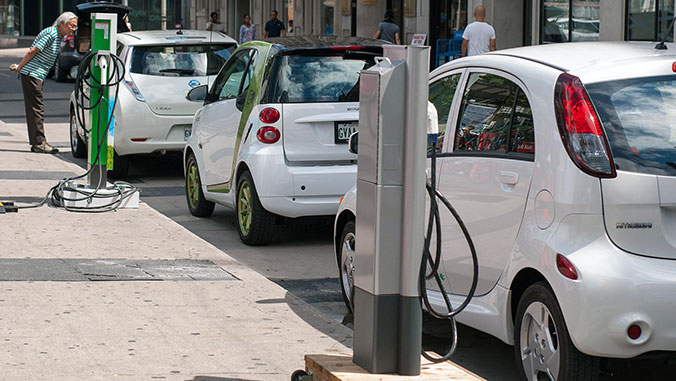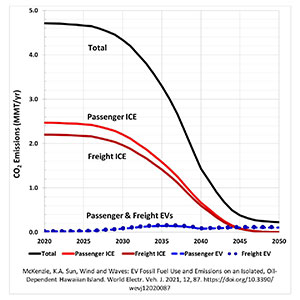
By 2050, faster adoption of electric vehicles (EVs) and faster generation of renewable energy will result in 99% less fossil fuel consumed and 93% less CO2 emissions from passenger and freight vehicles on Oʻahu. That’s under the most ambitious scenario in an article published in World Electric Vehicle Journal, by University of Hawaiʻi at Mānoa School of Ocean and Earth Science and Technology (SOEST) faculty member Katherine McKenzie.
McKenzie, based at the Hawaiʻi Natural Energy Institute in SOEST, created mathematical models of four scenarios based on projections for the switch to electric passenger and freight vehicles, and renewable power generation. She quantified the impacts of fossil fuel use and CO2 emissions on Oʻahu and found that scenarios with a slower transition to EVs result in billions more gallons of gasoline consumed, and tens of millions more tons of CO2 emitted.

As with many other remote communities still dependent on oil for both transportation and power, there remains a lack of critical analysis to determine the benefits of transitioning from internal combustion engine vehicles to plug-in EVs. In 2020, average passenger EVs were found to consume the equivalent of 66 gallons of gasoline, seven times less fossil fuel than their gasoline-powered counterparts, which used 455 gallons. Average EVs also cut emissions in half, two metric tons of CO2 versus four metric tons of CO2.
“Continuing to purchase anything powered by petroleum locks in emissions and energy insecurity for years to come, at a time when decarbonization is a climate imperative,” said McKenzie. “A shift is needed to energy efficient modes of travel—such as bicycling, walking and transit, along with reducing vehicle miles traveled (by “smart” city planning and remote work for example).”
These scenarios are intended as examples to assist government, regulatory, public and commercial decision makers and other stakeholders to better understand future uncertainties, develop strategies and inform the development of policy.

“The transition to EVs offers a momentous and immediate advantage to reduce fossil fuel consumption and resulting emissions for ground transportation in Hawaiʻi and similar regions, despite the current high dependence on oil for power generation,” McKenzie added. “As renewables, especially solar and wind, replace fossil fuels for power generation, escalating benefits are achieved with electric transportation in contrast to internal combustion engine vehicles. Accelerating both EV adoption and grid renewables will have striking cumulative benefits over the years, steeply reducing both fossil fuel use and emissions.”
McKenzie will present results from this study at the online conference “Utility Planning for Electric Vehicles on the Grid,” “EVs on the Grid: Impacts, Challenges & System Stability Risks” in collaboration with Hawaiian Electric Industries, on July 13, 2021.
This effort is part of UH Mānoa’s goal of Excellence in Research: Advancing the Research and Creative Work Enterprise (PDF), one of four goals identified in the 2015–25 Strategic Plan (PDF), updated in December 2020.
For more information see SOEST’s website.
–By Marcie Grabowski

